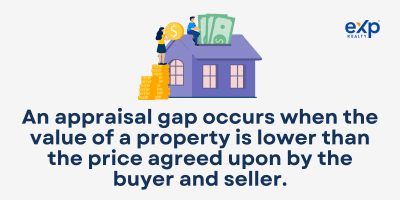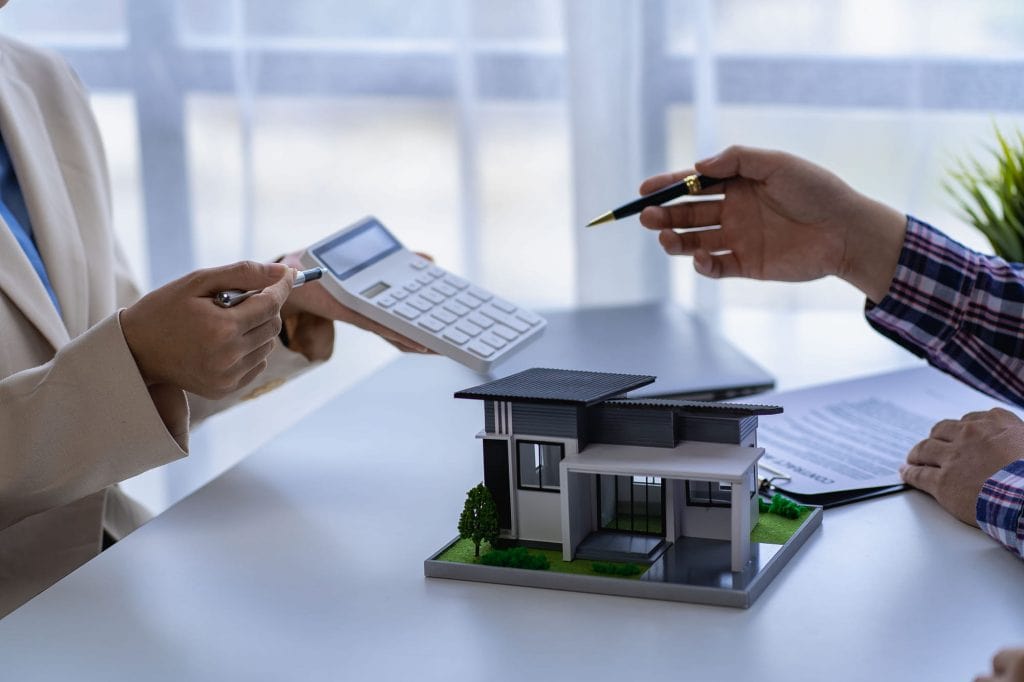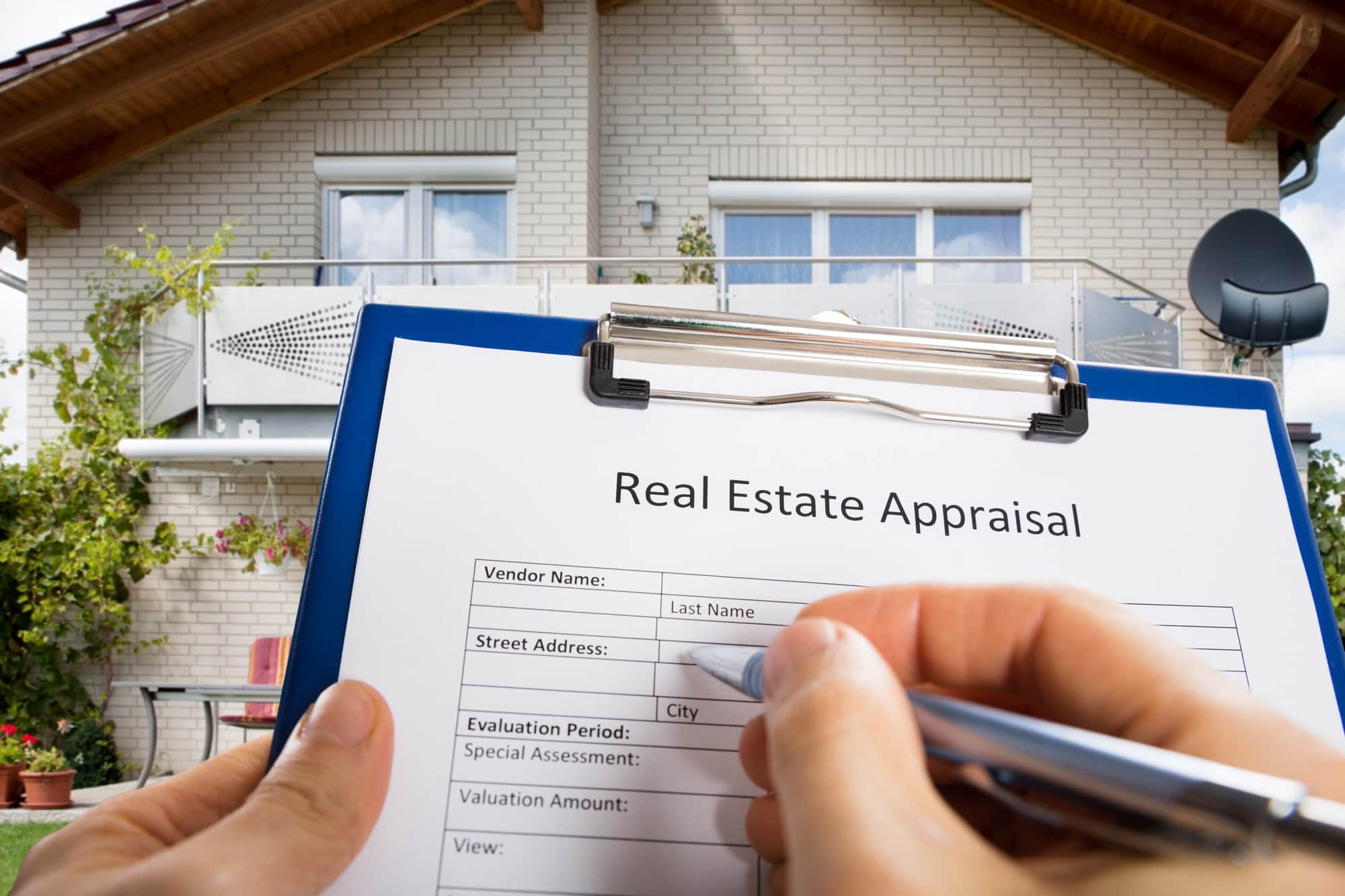Are you looking to buy or sell a home? Real estate transactions involve complex negotiations, inspections, and appraisals. And for many, the appraisal process can be a daunting and often confusing step in home buying.
Understanding the appraisal gap and its implications is crucial if you’re looking to avoid potential pitfalls. At eXprealty, we want nothing more than to help you make informed decisions, so we’ve prepared this guide for you.
This article will discuss how an appraisal gap occurs and what it means for buyers and sellers. Continue reading to gain valuable insight to help you confidently navigate the real estate market!
Understanding Appraisal Gaps
An appraisal gap occurs when the value of a property, as determined by a real estate appraiser, is lower than the price agreed upon by the buyer and seller. This means the mortgage lender may not approve a mortgage for the total amount needed to purchase the property, leaving the buyer to pay the difference out of their own pocket.
Say you agreed to buy a house for $500K, but the appraisal totals $450K. That means the appraisal gap is $50K. The lender will only provide a mortgage for the appraised value of $450K, leaving you to come up with an additional $50K yourself to complete the purchase.
In a seller’s market with more buyers than sellers, some sellers may require an appraisal guarantee clause. This clause means that if the appraisal comes in lower than the accepted offer, the buyer will have to pay the difference.
Factors That Contribute to Appraisal Gaps
The appraisal gap is a common phenomenon in the real estate market, and several factors can contribute to its occurrence. Let’s explore crucial factors that can lead to appraisal gaps.
Tight Housing Inventory
One of the primary factors that can contribute to an appraisal gap is tight housing inventory. When the supply of available homes is limited, buyers may be willing to pay more for a property than its appraised value. In such a situation, the seller has an advantage in negotiations, and the buyer may feel compelled to pay more than the property is worth.
In addition to driving up prices, tight housing inventory can lead to bidding wars among buyers, further increasing the likelihood of an appraisal gap. In a bidding war, buyers may offer more than the appraised value of the property in order to outbid their competitors and secure the home. This can leave the winning bidder with an appraisal gap to bridge.
Furthermore, tight housing inventory can make it difficult for individuals to find a property that meets their needs and budget, causing them to settle for a property that may be overpriced. This can increase the chances of an appraisal gap and leave the buyer in a difficult financial position.
Low Interest Rates
When interest rates are low, it means that more buyers are able to afford homes. As a result, there’s an increase in demand for homes, which can then lead to an increase in sale prices.
Now, in a competitive housing market, things can get pretty intense. Buyers may be willing to pay more for a property than its appraised value to secure a low-interest rate mortgage. They don’t want to miss the opportunity to lock in a great rate, so they’re willing to pay a premium to make it happen.
High Demand
High property demand is another factor contributing to an appraisal gap. With more buyers than available properties, sellers can demand higher home prices. In such a situation, buyers may be willing to pay more than the appraised value of a property to secure the home they want.
Other Factors
Aside from the ones mentioned above, other factors can also contribute to appraisal gaps. For instance, the location and condition of the property and the accuracy of the appraisal can directly impact the appraised value. Additionally, a lack of comparable sales data in the area can complicate the process of determining the property’s true value.
Why Does the Appraisal Gap Matter?

Simply put, the appraisal gap matters because it can have significant financial implications for homebuyers, homeowners, and sellers. When the appraised value of a property falls short of the purchase price, buyers may have to come up with additional funds to cover the difference or risk losing out on financing.
Homeowners may be unable to refinance or access equity, thus limiting their financial options. Sellers may need to lower their asking price or make costly repairs to attract buyers and close a sale.
But that’s not all. The impact of the appraisal gap goes beyond individual transactions and can contribute to a competitive real estate market with rising home prices. This means that buyers may have to compete for limited inventory and offer more than the appraised value to secure a property within their budget.
Tips on How to Bridge the Appraisal Gap
Dealing with an appraisal gap can be stressful, but there are effective ways to bridge the gap and make sure both parties are satisfied with the transaction. Here are some tips to consider.
Consider Alternative Financing Options
If the appraisal value falls short of the purchase price, buyers can explore other financing options, the likes of which include a larger down payment or a higher interest rate. Alternatively, they can seek lending options like a bridge or personal loan.
Negotiate With the Seller
Negotiating with the seller is another way to address the appraisal gap. Buyers and sellers can work together to find a compromise that works for both parties, such as reducing the purchase price or including additional contingencies.
Price the Property Appropriately
Sellers can also avoid appraisal gaps by pricing the property appropriately. This can be achieved by working with an experienced real estate agent that can conduct a comparative market analysis. Then the seller’s agent can determine a realistic and fair price for the property.
Make Repairs and Improvements
Making necessary repairs and upgrades to the property can also help increase its appraised value. Prioritizing repairs and upgrades before the appraisal can help bridge the gap and make the property more attractive to potential buyers.
Consider Alternative Appraisers
Another option is to consider alternative licensed appraisers. In some cases, the appraised value of a property can differ between individuals. Buyers and sellers can seek the services of a second appraiser to provide a different perspective, which can then bridge the appraisal gap.
Be Realistic
Lastly, being realistic about the current state of the real estate market is essential in bridging the appraisal gap. In a competitive market with high demand and low inventory, the appraised value may fall short of the purchase price. Understanding these market conditions and having a backup plan can help buyers and sellers navigate the appraisal gap successfully.
Key Takeaways

Understanding the appraisal gap is crucial when buying or selling a property in the real estate market. It can impact the number of funds a buyer needs to secure a property, limit a homeowner’s financial options, and/or require a seller to make additional repairs or adjust the asking price.
To bridge the appraisal gap, it’s important to consider alternative financing options, negotiate with the seller, ensure the property is priced appropriately, make repairs and improvements, consider alternative appraisers, and be realistic about the current market conditions. By doing so, buyers, sellers, and homeowners can make knowledgeable decisions and navigate the real estate market like a pro.
For more information on the appraisal process, consult with an experienced real estate agent at eXprealty! Our knowledgeable professionals are here to simplify the process for you and guide you every step of the way.
Buying and selling a home doesn’t have to be difficult. With the help of our passionate team, you can fulfill all of your real estate dreams. Feel free to search our website for properties and sign up to get alerts for new listings!
FAQs: Appraisal Gap
Here are some frequently asked questions about appraisal gaps.
Is appraisal gap coverage a good idea?
Appraisal gap coverage can be a good idea for homebuyers, considering it provides protection in case the appraised value of the property is lower than the purchase price.
How do you explain an appraisal gap?
An appraisal gap occurs when there is a difference between the appraised value of a property and the actual purchase price. It can be caused by various factors, including low inventory, high demand, and market conditions.
What’s the difference between appraisal gap coverage clause and appraisal contingency?
Although it may seem like it, appraisal gap coverage is not an insurance policy. It actually refers to a section in the contract that obliges you to purchase the house regardless of the appraised value. It is important to review this part of the contract carefully and either request it to be deleted or specify a maximum amount you are willing to pay in order to cover any appraisal gap.
If there’s an appraisal contingency in the purchase contract, it means that if the appraised value does not match your agreed-upon sales price, you can legally exit the contract without losing your earnest money. However, if you did not have this contingency in place and decided to opt out of the contract, the seller would be able to keep your earnest money, which typically ranges from 1% to 3% of the sales price.
Do I need an appraisal gap coverage clause?
It might be necessary if you want to avoid dealing with a potential appraisal gap and pay top dollar. The appraisal gap clause specifies the amount you are willing to cover in case there is a difference between the appraisal value and the agreed-upon sales price. The sellers usually require this assurance because an appraisal may come in at a lower value than expected, and they want to ensure the offer will still be valid.
The appraisal gap coverage clause requires you to come to a mutual agreement with the seller regarding the amount you are willing to pay above the appraised value and whether you wish to split the difference.
How do you write an appraisal gap clause?
To write an appraisal gap clause, you’ll need the help of a real estate agent or attorney. These individuals can help you create a contract clause outlining how any appraisal shortfall will be handled by both the buyer and seller.
What is an example of an appraisal gap?
An example of an appraisal gap is when a buyer agrees to purchase a property for $500K, but the appraisal value comes in at $450K.
Who determines the appraisal gap?
The appraiser determines the appraisal gap by assessing the value of the property on the basis of various factors, including location, size, condition, and comparable sales.
Can I dispute an appraisal gap?
If buyers or sellers disagree with the appraisal, they can dispute it by asking for a reconsideration of value. However, gathering enough evidence to prove the appraisal is inaccurate can be a challenging task. To contest the appraisal, you need to show evidence for one of the following reasons:
- The appraiser used inappropriate comparable sales, and better options are available.
- The appraiser did not include features or upgrades present in the subject property.
- You discovered mistakes in the appraisal report.
- The appraiser only did a drive-by or exterior appraisal.
If you want to challenge the appraisal, you need to write a letter explaining why you disagree with it and provide evidence to support your argument. The letter should be brief, courteous, and include as much supporting research and proof as possible. Make sure to submit your letter in writing.
How do you negotiate an appraisal gap?
To negotiate an appraisal gap, buyers can request a second appraisal, renegotiate the purchase price with the seller, or seek alternative financing options.
What happens when the appraisal is lower than the offer?
When the appraisal is lower than the offer, the buyer may need to bring additional funds to cover the difference or renegotiate the terms of the sale.
Should I pay the appraisal gap?
It is up to both the buyer and seller to determine whether the appraisal gap should be paid. The two must negotiate and come to a mutual decision. If the seller refuses to lower the price and you don’t have an appraisal contingency in your contract, you will have to pay the additional cost.
If there is an appraisal contingency, you can back out of the contract and keep your earnest money. However, if there is no appraisal contingency, you either have to purchase the home or risk losing your earnest money.
If the sales price remains the same, you will have to pay a higher amount for the home. This is because lenders determine your loan amount based on the appraised value. Therefore, you will need to pay your decided-down payment amount along with the gap between the appraised value and sales price.
How can the buyer pay the appraisal gap without cash?
If you don’t have the difference in cash, you can either ask your family members for gift letters or use your investments as leverage. To avoid paying a penalty, explore using retirement funds by speaking with your 401(k) administrator or tax adviser. Another option is to utilize the equity in any other properties you own to cover the appraisal gap.
How common is an appraisal gap?
An appraisal gap is becoming increasingly common in today’s competitive real estate market, especially in areas with high demand and low inventory.
Can you get a loan to cover the appraisal gap?
Yes, buyers can seek alternative financing options such as a personal loan or a bridge loan to cover the appraisal gap. However, these options may come with higher interest rates and additional fees.





